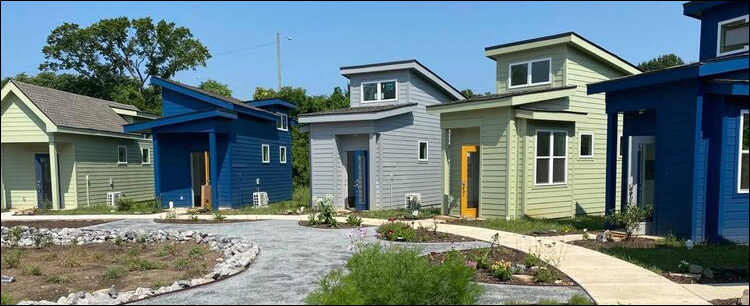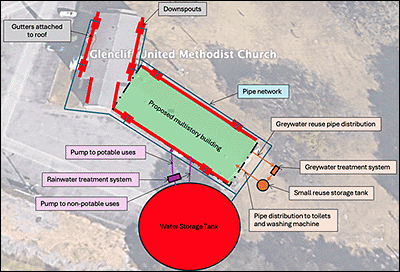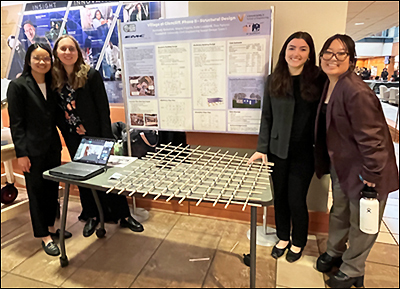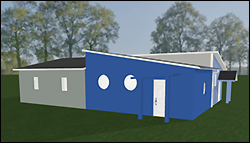
When civil engineering students met to choose their senior capstone design projects, they all wanted to work with The Village at Glencliff (TVG), a respite community of 12 tiny homes for some of Nashville’s most medically vulnerable homeless citizens that provides a safe place to recover after a hospitalization. So, they created three projects for one client.
“Working with recovery patients from Vanderbilt University Medical Center, professional mentors, the Nashville Civic Design Center, and all the civil engineering seniors really made it feel like we were making an impact in Nashville,” said Ada Novak, who worked on a water reuse systems project. “The collaboration among all parties was the coolest part.”

Students designed three options to treat and recycle water for the tiny homes. Another team created Phase II site plans for TVG’s expansion and third team provided structural designs for multi-story and quadplex buildings for the expansion space. The local nonprofit has begun a fundraising campaign to add much-needed supportive housing to its campus on land donated by the Glencliff United Methodist Church.
“As a mentor, guiding future engineers as they tackled real-world water reuse challenges in our community for The Village of Glencliff was an honor and a privilege,” said Jennifer Osgood, P.E., senior vice president, CDM Smith, and an industry leader in water quality and treatment. “The students worked diligently and truly wanted to make an impact with their efforts.”

“Working with Jennifer was so beneficial to understanding all the necessary water calculations and the current governmental policies and finances to consider when working on water projects for a client in Nashville,” said Novak, who accepted a job after graduation at engineering services company WSP USA in New York City.
The interdependence of the projects felt meaningful to the students, said Lori Troxel, professor of the practice of civil and environmental engineering and senior design adviser. “The teams had to collaborate and that’s frustrating at times, and a little more real world. Some teams were ahead, some weren’t. Their mentors said, ‘This is the way it is. Keep moving forward.’”

The structural design team evaluated a novel, thin-shell concrete hyperbolic paraboloid roof for the quadplexes that would increase the buildings’ efficiency by allowing rain capture, minimizing lifetime maintenance costs, and maximizing material strength. They produced a scaled model of the paraboloid roof that appealed to their mentors. “It was important to the team that this was not just an academic exercise. They were designing a building to meet actual needs of actual people,” said Dan Borsos, P.E., president emeritus of EMC Structural Engineers and team mentor.

“This project represented a big leap in their education. In class they had learned the theory–how to design a steel beam. In this project they moved on to how that beam functions in the building, how it interacts with other building elements, how to represent that beam in design documents, and what it will actually look like when completed. These are things an engineer typically learns in their first job. This senior project gave them a head start,” Borsos said.
The hillside site proved to be tricky. “Based on the feedback from the residents and our mentors, we were able to navigate structural design problems and site problems like stormwater management and ADA compliance,” senior Laura Kwon said. “It was exciting because the project was more than just an academic exercise. It was an opportunity to make a real difference in people’s lives.”
The development of soft skills, particularly communication and presentation abilities, are crucial in the engineering field. Final presentations to The Village at Glencliff’s leaders, mentors and at the Civic Design Center allowed students to practice public speaking skills and articulate their design process.

The students’ consideration of long-term impact showed they understood the importance of their work beyond the design phase. Students met with The Village at Glencliff Executive Director Julia Sutherland early in the process to understand how to shape their deliverables to be helpful to the nonprofit when seeking funding.
The multifaceted nature of the projects was an ideal example of what a senior design project could accomplish. “Our work with The Village at Glencliff epitomized all of the best things a senior design project can and is intended to be,” said senior Harmony Bickerton, who now works at CDM Smith.
While Phase II site work started before the students began their projects, it is likely to change, Sutherland said. “When we shared our dream with the students we said, ‘We’ll see what they come back with.’”
Impressed by the final presentations, “It won’t be far off,” Sutherland said.
Contact: brenda.ellis@vanderbilt.edu